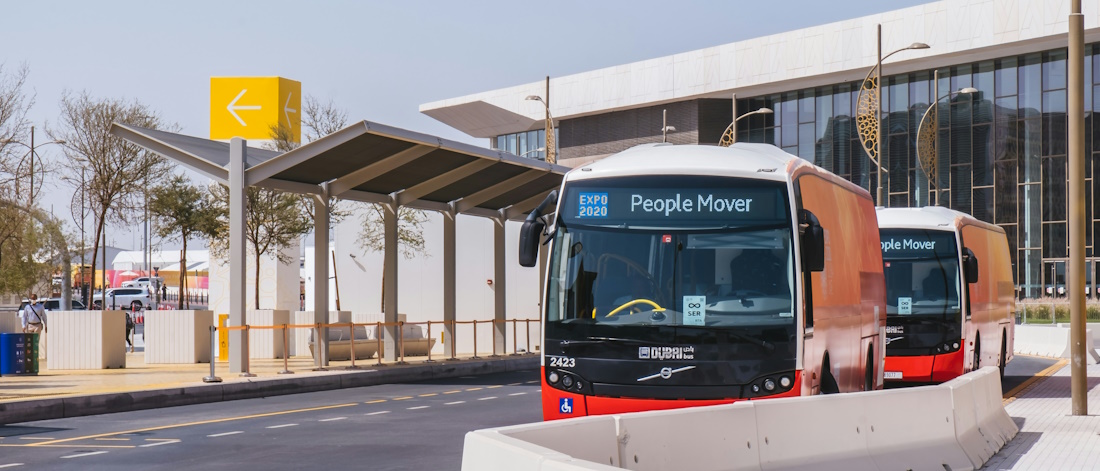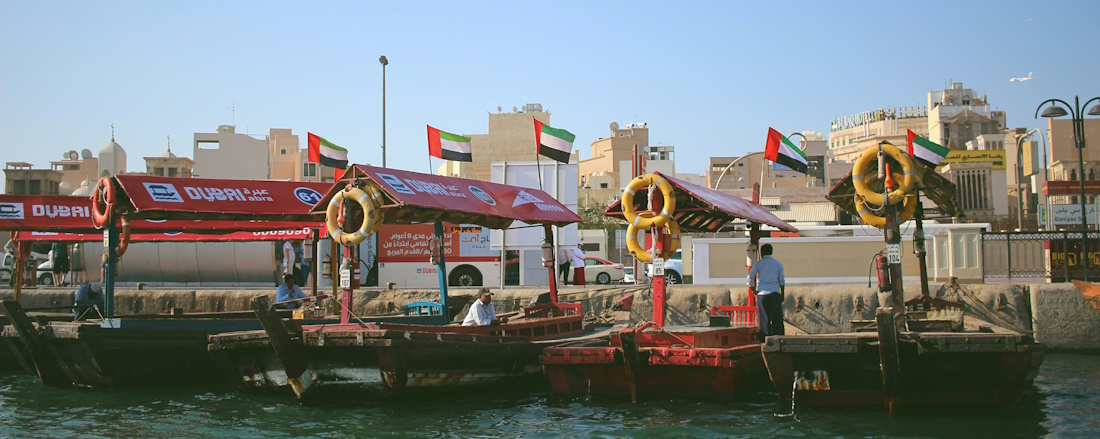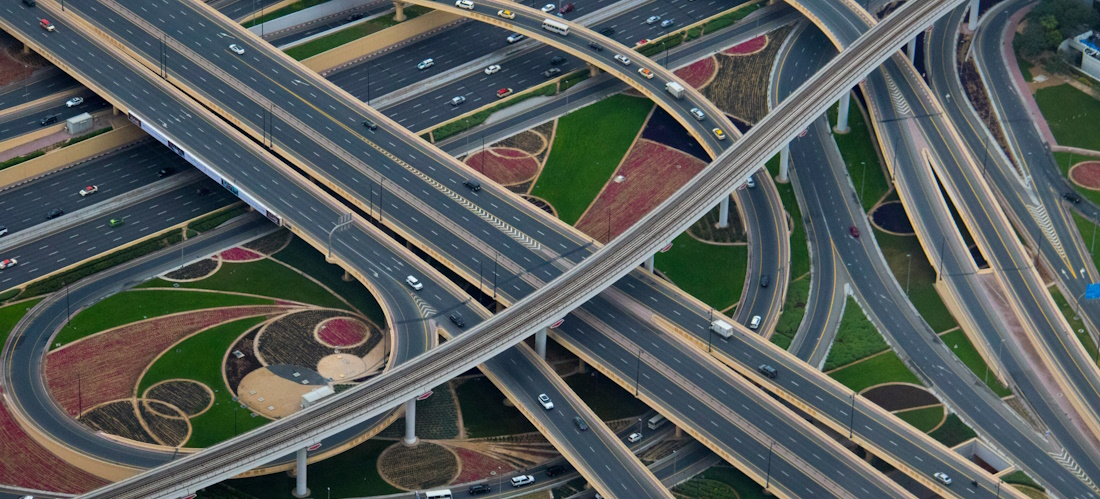- Download our Dubai Schools Guide
- Download our Moving to Dubai Guide (PDF)
Dubai consists of two distinct areas, each with its own transport infrastructure. The original city was built around the Creek (an inlet from the Arabian Gulf), and the relatively new developments are located nearby in New Dubai.
The original city is reasonably compact, pedestrian-friendly – at least from about October through April when the weather is good – and has pretty reliable and efficient public transport options. Those using private vehicles will quickly discover that traffic is terrible and parking is usually difficult to find. Available options are often expensive, limited to either parking meters or car parks.
New Dubai, on the other hand, was designed mainly for cars. Individual developments, such as Dubai Marina, are pedestrian-friendly, but as New Dubai sprawls across an extensive area, getting from one development to another requires transport.
Most expats own a car – typically more than one per family – as cars in Dubai are reasonably priced and petrol is cheap.
Public transport in Dubai

Paying for public transport in Dubai is made easy and convenient by the Nol card and the Nol ticket system. The Nol card, a contactless smart card, can be loaded with credit for single journeys or various passes for frequent commuters. It's a versatile option that can be used across multiple modes of transport, including the Dubai Metro, buses, trams, water buses and even for access to RTA's paid parking zones. Different Nol cards, such as Red, Silver, Gold and Blue, each offer unique benefits and fare options.
On the other hand, the Nol ticket is a paper-based card available for a small fee and is ideal for occasional users of the Dubai Metro, including tourists. It's an anonymous card, suitable for temporary use while visiting the city.
Cash payments are not accepted on the Dubai Metro, so having a Nol card or ticket is essential for using public transport in Dubai. Nol cards and tickets can be purchased at various locations, including ticket offices at Dubai Metro stations, Dubai Bus stations and supermarkets like Carrefour and Spinneys.
Buses
Dubai boasts a large and expanding bus fleet covering most of the city. These red-and-white buses are known for their cleanliness, maintenance and efficient air-conditioning systems, ensuring a comfortable ride for passengers. Buses are numbered, with their destinations displayed in both English and Arabic.
Special feeder buses are designated by an 'F' before the route number for those planning to connect to the Dubai Metro. These buses are easily identifiable by their blue hue.
Metro
The Dubai Metro is a popular and reliable mode of public transport in the city. The well-maintained and user-friendly online system offers valuable information on destinations, travel costs, purchasing e-cards for swift access, and more. Currently, the Dubai Metro system comprises two lines, the Red Line and the Green Line, with plans for three additional lines.

Abras and water buses
Dubai Creek, an inlet of the Gulf, runs through the centre of the original city, with Deira on one side and Bur Dubai on the other. Crossing the Creek is an experience in itself and can be accomplished through the traditional and fun wooden abras – small, open timber ferries that accommodate 20 passengers on benches in the centre of the vessel. Alternatively, modern water buses are available for those seeking air-conditioned comfort. For drivers, numerous bridges and a tunnel cross the Creek.
For more information on Dubai's public transport and travel options, visit the Dubai Roads and Transport Authority (RTA) website.
Taxis in Dubai
Dubai offers an extensive network of taxis, primarily Toyota Corollas. These taxis are known for their reliability and affordability. They are metered, air-conditioned and maintained to high standards, with uniformed drivers.
In addition to the standard taxis, Dubai also provides special service taxis, including ladies-only taxis with female drivers and taxis equipped for passengers with disabilities. Taxi ranks are conveniently located throughout the city, and passengers can easily flag down a cab on the street or request one by phone.
For added convenience, ride-hailing services have become increasingly popular in Dubai. Apps like Uber and Careem streamline communication with drivers and make payment hassle-free.
Useful links
Driving in Dubai

Once a residence visa has been secured, expats can legally buy a car in Dubai. Most well-known makes from the US, Europe, Japan and Korea are readily available, and the dealers have extensive workshops for service and repair.
Buying is not difficult, and new car dealers will arrange the registration on behalf of the buyer. For used cars, the buyer and seller must go to the traffic police to register the transfer. There are used car dealers, private sales and small private repair/service workshops all over the emirate.
Cars must be inspected and registered annually, insurance follows the usual international system, and fuel is cheap.
Vehicles are left-hand drive. Road signage is in English and Arabic but can be confusing and incomplete. Green road signs indicate the main locations within Dubai. Blue signs show the directions to other emirates, brown indicates landmarks, and white is for street names.
Car safety
Road deaths in Dubai have been among the worst in the world, but the police are working hard to improve driving standards, especially by curbing speeding. There is an increasing number of fixed and mobile radars, unmarked police cars, red-light cameras and a licence black-mark system; vehicles can be confiscated in serious cases.
The roads are new, well made and flat. They often have several lanes in both directions, and there are huge intersections on major roads with flyovers and tunnels.
Car crime is rare in Dubai, although normal precautions should be taken, such as locking the car and not leaving valuables in open view.
Driving licences
Expats in Dubai can typically obtain a local driving licence by converting their home country's licence. The process and eligibility criteria for conversion vary based on the expat's nationality. Some countries, such as the US, allow for a straightforward conversion without needing a driving test, while others may require additional steps.
The validity of the converted UAE driving licence is typically one year for individuals below 21 years of age and two years for those above 21 years.
For more information on obtaining a Dubai driving licence, visit the official Roads and Transport Authority (RTA) website.
Walking in Dubai
Dubai offers a mix of pedestrian-friendly areas and challenges when it comes to walkability. Dubai's overall walkability is influenced by its climate and car-centric urban design. On the other hand, some areas like Dubai Marina, Downtown Dubai, the Historic Al Fahidi Neighborhood, the Walk at JBR (Jumeirah Beach Residence) and City Walk are designed with pedestrians in mind.
The condition of sidewalks varies across the city. In certain areas, well-maintained sidewalks are available, while in others, they may be limited or interrupted by cross-traffic, making walking challenging. Walking in specific pedestrian-friendly zones can be enjoyable for tourists, but for longer distances, it's advisable to combine walking with public transport options.
Cycling in Dubai
Dubai is gradually embracing cycling, with ongoing infrastructure improvements to make the city more cyclist-friendly. While Dubai is primarily designed for cars, dedicated cycling lanes are being developed, aligning with the city's vision to become the world's most bike-friendly city by 2040. Notable projects like The Loop, a 58-mile (93km) sustainable urban highway designed for cycling and running, enhance cycling options.
However, it's essential to consider the weather, as extreme heat can deter cycling for a significant part of the year. Bicycles are not allowed on roads with speeds exceeding 37 miles per hour (60km/h), emphasising the importance of integrating cycling with public urban transport.
What do expats say about public transport in Dubai?
"I am not a fan of public transportation, as it makes you less flexible, but generally the metro line is quite big – doesn’t reach all the areas of the city though." Read more of our interview with Zaïnab, a Moroccan expat living in Dubai.
"The public transport here is excellent. You can even get yourself an Uber helicopter! The metro is clean, affordable and cost effective, the trams operate between areas such as JBR and The Palm Jumeirah. There’s three main taxi services, RTA, Hala and Careem." Read more from South African expat Schalk.
"Public transport here is amazing! You can literally just walk outside your building and find a taxi or use Uber and get picked up in a fancy car like a Lexus. The public transportation like the bus and train is very good. You have a train coming every few minutes. The buses and trains are clean, modern and easily accessible for everyone." Read more about Cormandré's experiences in Dubai.
Further reading
►Thinking about purchasing a vehicle? Learn all about Buying a Car in Dubai.
Photo credits: Al Wasl Bus Stop by Ravigopal Kesari, Abras on Dubai Creek by J Shim, View of Dubai Road Network from Burj Khalifa by Nick Fewings, all on Unsplash.
Are you an expat living in Dubai?
Expat Arrivals is looking for locals to contribute to this guide, and answer forum questions from others planning their move to Dubai. Please contact us if you'd like to contribute.
Expat Health Insurance
Cigna Global Health Insurance.
Medical insurance specifically designed for expats. With Cigna, you won't have to rely on foreign public health care systems, which may not meet your needs. Cigna allows you to speak to a doctor on demand, for consultations or instant advice, wherever you are in the world. They also offer full cancer care across all levels of cover, and settle the cost of treatments directly with the provider.
Moving Internationally?
International Movers. Get Quotes. Compare Prices.
Sirelo has a network of more than 500 international removal companies that can move your furniture and possessions to your new home. By filling in a form, you’ll get up to 5 quotes from recommended movers. This service is free of charge and will help you select an international moving company that suits your needs and budget.
Get your free no-obligation quotes from select removal companies now!


